First person view (FPV) drones offer an exciting flying experience for pilots, and the best FPV drones available provide a range of options for beginners and experts alike. FPV drones are well-known for being complicated, whether self-build or bind and fly models, but ready to fly (RTF) kits allow new FPV pilots to get flying simply after charging everything that comes in a complete kit.
RTF FPV drone kits typically include the drone, a controller, FPV goggles, two batteries, a charger, spare propellers, and a case which makes getting started incredibly easy. The holy grail of FPV drone flight is flying in Manual/Acro mode, but this takes a great deal of practice. Many experts suggest you need around 50 hours of flight between a beginner drone and an FPV simulator to become a competent pilot.
Most FPV controllers can be plugged into a Mac or PC to control FPV flight simulators which is a great way to begin flying FPV drones without the risk of damaging your drone in a crash. Plus, many RTF drone kits include drones with three flight modes that are designed to make learning to fly easier, allowing you to build up to Manual/Acro mode, which is the most difficult yet most rewarding mode to fly in.
First person view (FPV) drones offer an exciting flying experience for pilots, and the best FPV drone available provide a range of options for beginners. FPV drones are well-known for being complicated, whether self-build or bind and fly models, but ready to fly (RTF) kits allow new FPV pilots to get flying simply after charging everything that comes in a complete kit. the drone while constantly regulating the throttle and manually levelling the drone on the pitch and roll axis. FPV flight takes a lot of practice, but it’s also a huge amount of fun and RTF kits make it accessible to anyone.
For more advanced models, we have a more general guide to the best drones, but we have a best beginner drones list too. Also, it’s that time again, so if you’re looking to save some serious cash, then check out our guide to the top drone deals we could find.
Best FPV drone overall
If you’re looking for an FPV drone that combines the flight conveniences of camera drones such as GPS positioning and downward sensors, alongside the ability to fly in Manual/Acro mode, the DJI Avata is the drone for you. The two kits available come with the DJI Motion Controller, which is an intuitive control device. But for full flight control, and to fly in Manual/Acro mode, you’ll need to purchase the DJI FPV Remote Controller 2 separately.
The DJI Avata features a cinewhoop design with prop guards around the propellers to protect them in the event of a crash. These can be purchased separately and replaced if damaged. The drone is 180 x 180 x 80 cm and weighs in at 14.46 oz/410 g with a battery, which is heavy for a drone of this style, but it does include 20 GB of built-in storage alongside a microSD card for additional storage.
The video quality from the 48MP 1/1.7-inch CMOS sensor with an f/2.8 lens with a 12.7 mm equivalent focal length is excellent overall. Video can be captured in 4K up to 60fps, 2.7K at up to 100fps and 1080p at up to 100fps with DJI Goggles 2. With the DJI FPV Goggles V2, 2.7K and 1080p video can be captured up to 120fps. The Avata is available standalone or in two kits offering different goggle options and a Fly More Bundle is also available.
Best value 4K FPV drone
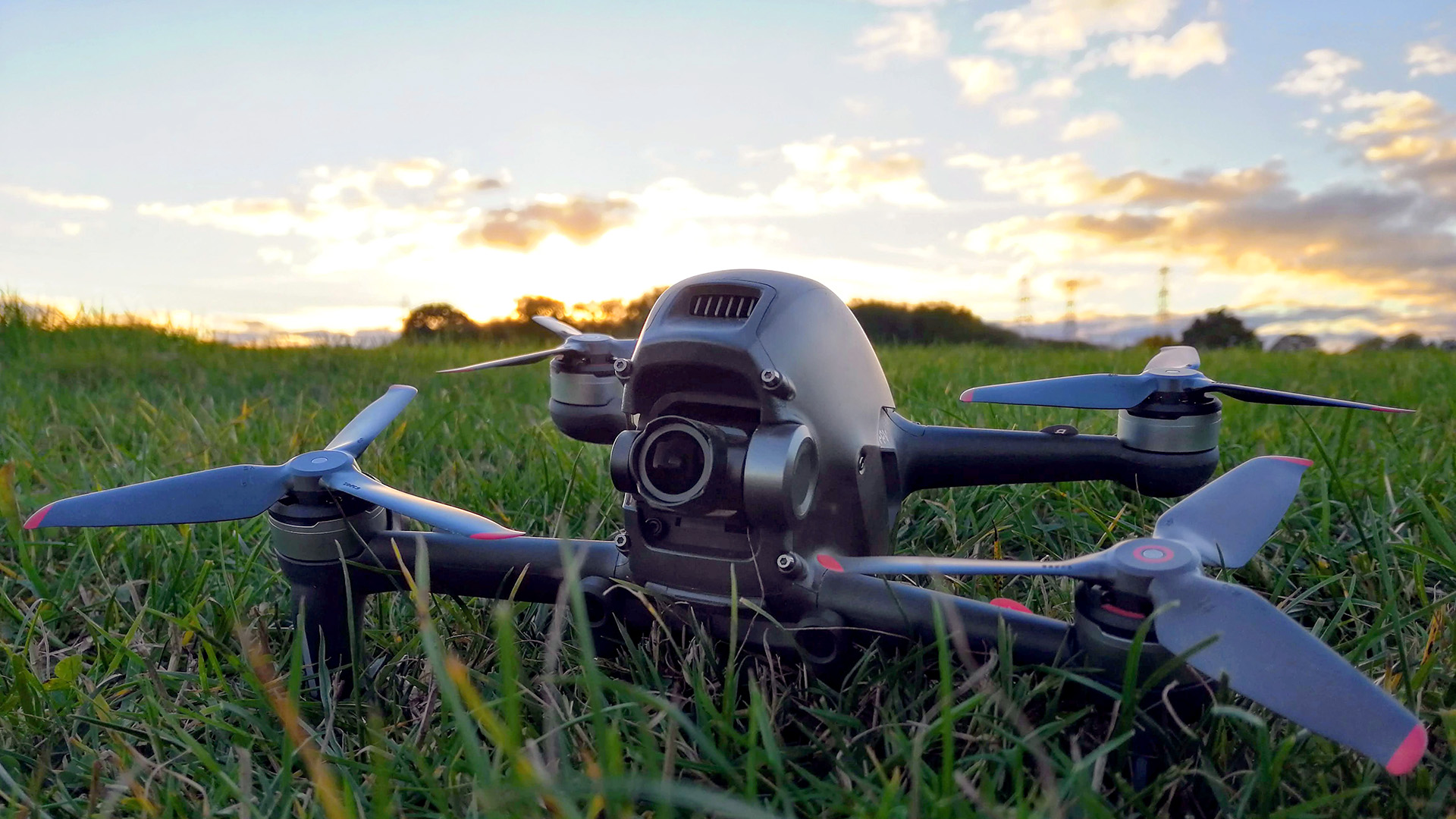
The DJI FPV was DJI’s first attempt at producing an FPV drone and it was received with mixed reviews because it’s larger and heavier than traditional FPV drones. The DJI FPV features GPS positioning in Normal mode so it can be flown like a camera drone if you’re a beginner. And another safety feature in this mode is sensors that will slow the drone, but won’t stop it if an obstacle is detected.
Sport mode offers flight speeds up to 60 mph, while Manual can achieve an impressive 87 mph. However, this mode is only for experienced FPV pilots who can fly manually. Sport mode is a hybrid mode that turns off the downward sensors and provides an exhilarating flight experience despite not being the fastest available. The drone comes with the DJI FPV Remote Controller 2 and is also compatible with the DJI Motion Controller which can be purchased separately.
The camera provides both the digital FPV video feed as well as the ability to capture immersive footage up to 4K at 60fps. This can be captured in the Standard color profile for straight out-of-camera footage, or in D-Cinelike (Raw) for color grading and incorporating into a professional workflow. At over a year since its release, the DJI FPV is available for a competitive price.
Best FPV drone for beginners
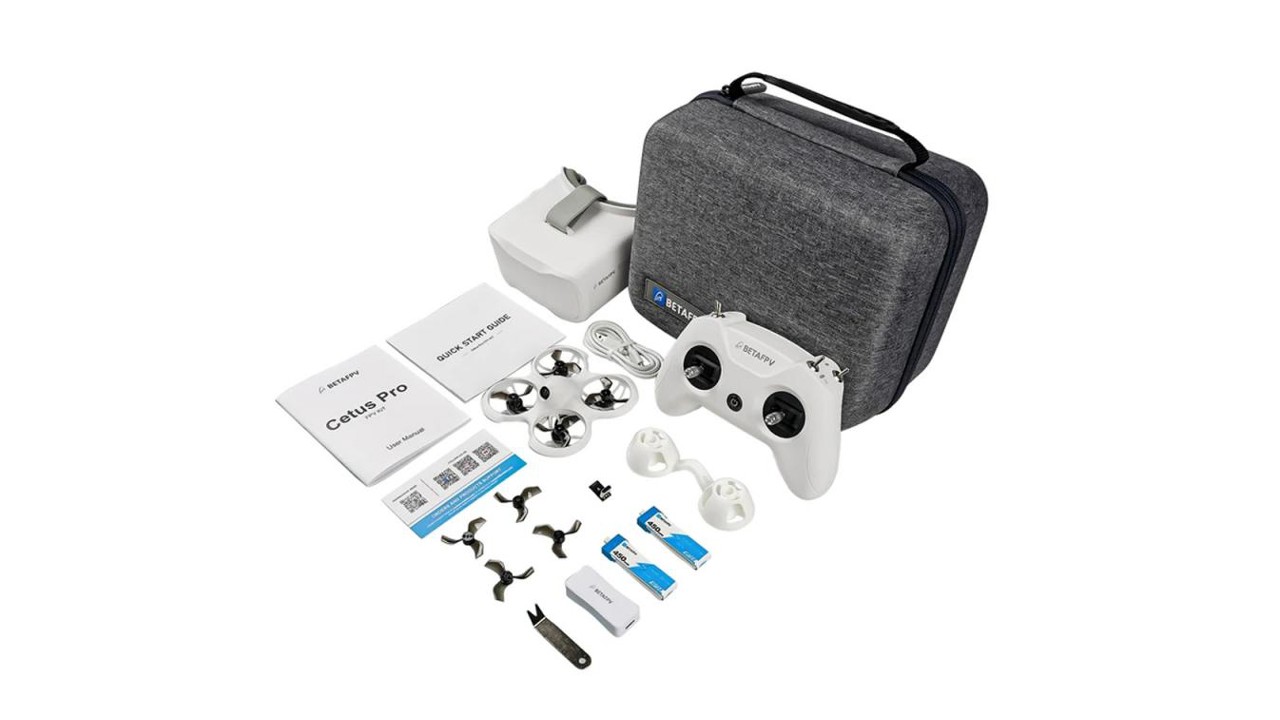
The Cetus Pro Kit is aimed squarely at absolute FPV beginners and those who would like a tiny FPV drone they can take anywhere. The kit comes with everything you need including the drone, FPV goggles, a controller, a carry case, two batteries, and a USB charger and voltage tester and other accessories.
The Cetus Pro features optical flow sensors in Normal mode to help the drone to hold position and to fly over obstacles below. This basic mode is the starting point for beginners, while Sport mode restricts the angle the drone can be pitched or rolled. Manual mode is fully manual as the name suggests and requires lots of practice to be able to fly using it. There are also three speed modes available in the three main flight modes, so you can slowly build up to Fast speed in Manual/Acro mode as your flying skills improve.
You’ll crash often in the early days and the robust design of the Cetus Pro means damage is unlikely. And when you do crash upside down, Turtle mode allows you to flip the drone and take off without having to walk over to the drone. The small batteries provide up to five minutes of flight, and although the 800x480p resolution of the goggles is good, with an unobstructed range of up to 80 m, you have to keep the drone relatively close to you to avoid losing the video feed.
Best cheap FPV drone
Advertised as being for indoor flight thanks to its tiny whoop design with foam padding around the propeller guards, the GepRC Tiny Go 4K is a unique beginner RTF kit. Indoor flight is difficult in reality, but the drone is powerful enough to fly outside, although strong wind would be problematic. However, the most interesting feature of the drone is that it can capture 4K video at 60fps alongside the FPV feed.
This is great, but with no gyro data recording available the footage can be shaky. Quality is good overall, but not to the same quality level as an action camera or DJI’s FPV drones; it’s a welcome and indeed rare feature for drones of this type, and the ability to capture 4K video of flights will be an attractive option for many new FPV pilots. Plus, the goggles have a DVR built-in so you can also record the FPV feed.
The kit comes with the drone, goggles, a controller, four 1S batteries (two are used to power the drone), a USB battery charger, a carry bag, and accessories. The goggles are the box type and offer an 800x480p resolution which is pretty standard for beginner RTF kits, and the transmission range of the receiver is 100 m so you can’t fly the TinyGo too far away from you.
Best FPV freestyle drone
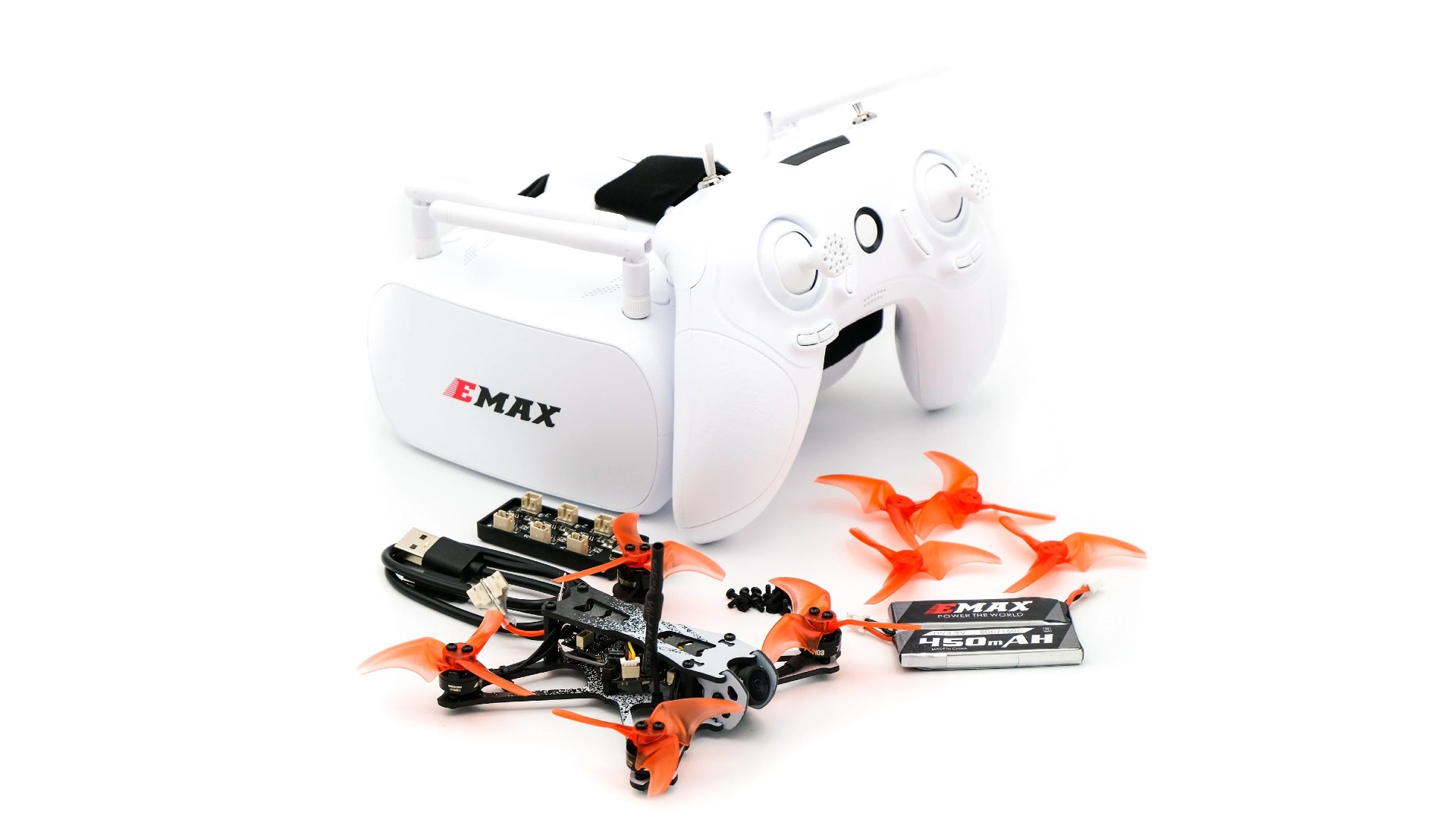
One of the most attractive aspects of FPV drones is the ability to fly freestyle. Not only is it exciting, but the video you can capture when you become skilled can look amazing. The Emax Tinyhawk II RTF Kit provides everything you need to get started in FPV, but with a freestyle-focused drone. The tuning is fairly sedate making it well-suited to beginners, and you can perform basic tricks with the Tinyhawk II.
The controller looks like a gaming controller and less like an FPV controller; you get the controls you’d expect, but the control sticks are strange and may not appeal to everyone. Three flight modes help you develop as an FPV pilot; Air mode where the throttle runs higher to help to stop the drone from dropping out of the sky, Angle mode where pitch and roll are limited, and Manual/Acro mode.
Despite its small size, you can purchase 3D printed camera mounts for the Insta360 Go/Go 2, and the drone can fly with these small cameras attached, although flight times are reduced due to the additional weight. The goggles feature a lower resolution of 480x320p compared to the 800x480p of most of the other analogue goggles included in RTF kits.
Best FPV racing drone
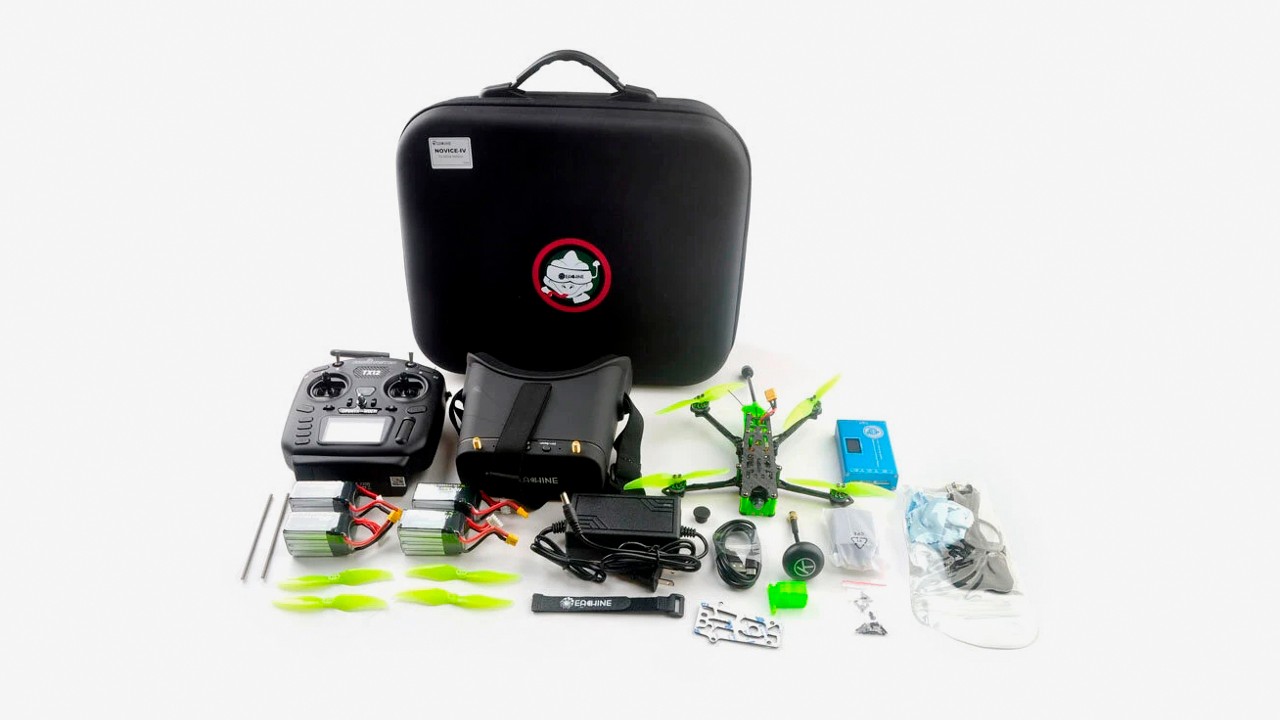
Despite being a beginner kit with everything you need to get started, alongside three flight modes to cater to different skill levels, the Eachine Novice-IV Kit could be classed as an intermediate RTF kit thanks to its impressive features and functionality. This includes a beeper for locating the drone if it crashes out of sight, and a built-in GPS is designed to make the Novice-IV return to home if the connection with the controller is lost.
The controller itself is a multi-protocol Radiomaster TX12 so it can be used with many different FPV drones. It’s a budget model from Radiomaster, but still a great option to come included in the kit and one that could provide years of use. The Novice-IV kit comes with two or four 1100mAh 4S XT30 LiPo batteries that Eachine claims can provide up to 20 minutes of flight time and a basic charger is also included alongside goggles, a case, and accessories.
The goggles come with a mushroom and patch antenna for improved connection and have the highest resolution of analogue kits in this guide at an impressive 900x600p. There’s also a DVR built-in so you can record the FPV feed at a resolution of 720x576p. All in all, this is an impressive kit that could easily suit your needs from beginner to intermediate FPV pilot. Plus, the Novice-IV can carry lightweight cameras such as the Insta360 Go/Go 2 and naked action cameras.
Best FPV racing drone for beginners
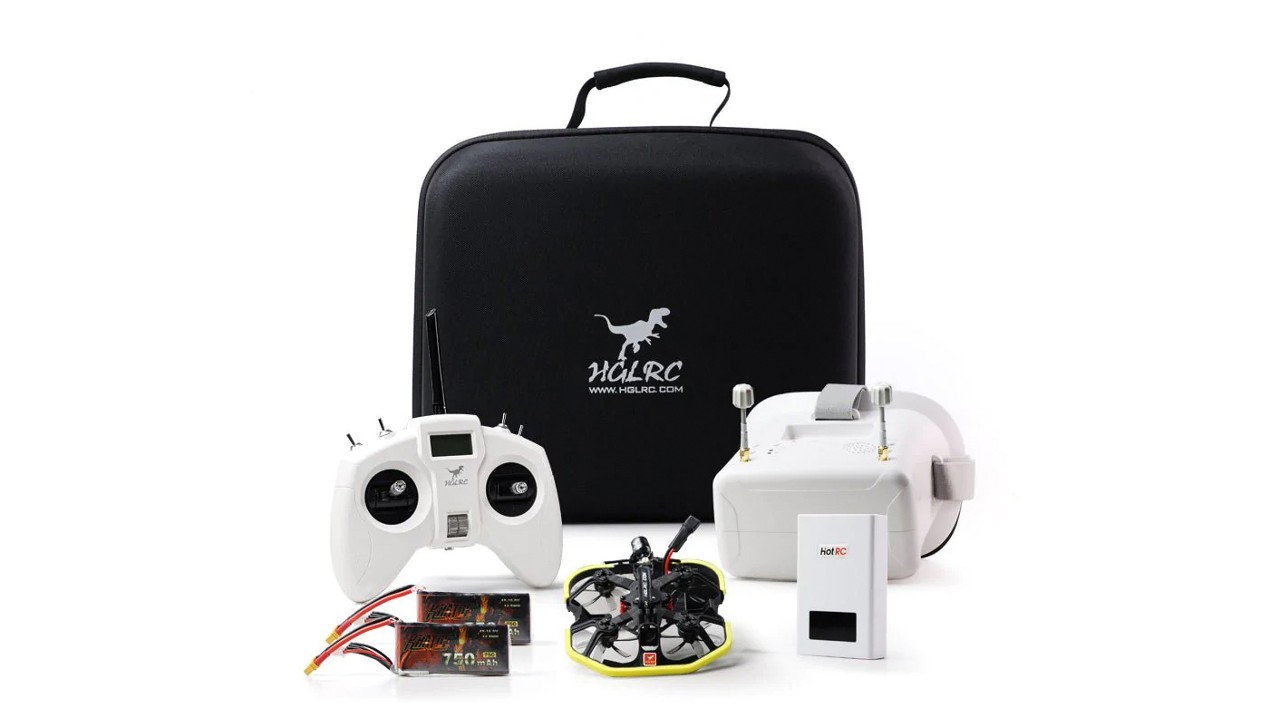
Sporting a go-kart inspired design and the ability to connect a small and lightweight action camera, the HGLRC KT20 2in FPV Racing Drone Analog RTF Kit is beginner-friendly with room for you to grow as an FPV pilot. The kit provides everything you need to fly including the drone, FPV goggles, controller, batteries, charger, a carry case, two 4S 750mAh LiPo batteries, a charger, and accessories.
Most FPV drones in the RTF category run on 1S or 2S batteries, but the HGLRC KT20 uses 4S batteries which offer longer flight times and more power. Flight times aren’t advertised because this can depend on several factors, but with two batteries included and the availability of 4S XT30 batteries from a range of manufacturers, it’s cost-effective to stock up.
The goggles that come in the kit are analogue box goggles with an 800x480p resolution which is typical for analogue RTF kits. They’re perfect for getting started and provide a clear enough video feed from the drone’s camera for flight. The screen is IPS and the goggles also feature a DVR for recording the FPV feed to a microSD card, plus the diversity antennas are designed to provide an improved connection to the drone.

